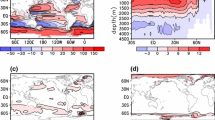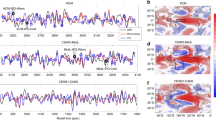Abstract
A “diagnostic multi-model ensemble potential predictability study” of surface air temperature is performed using data from nine models participating in the Coupled Model Intercomparison Project (CMIP1). The data are considered to be a sample of results from the population of models “embodying current abilities to simulate the climate system” and represent a range of numerics, resolution and of physical parametrizations. The potential predictability of pentadal, decadal, and 25-year means is analyzed. The multi-model ensemble provides a statistically stable estimate of the potential predictability variance fraction (ppvf) with a narrow confidence interval. This is not the case for individual models with modest lengths of simulation data nor, by implication, for the instrument-based observational record. Potential predictability is found predominately over the high-latitude oceans. There is evidence also for potential predictability at tropical latitudes in the Pacific and Atlantic, but not the Indian oceans, on the shorter of the time scales. The potential predictability variance fraction decreases with increasing time scale but appreciable values exist at all of the time scales considered, especially for the Southern Ocean and for the North Atlantic. Values over land, while statistically non-zero, are small. The autocorrelation structure of the data is investigated to account for its effect on the statistical estimation of the ppvf and to indicate the extent to which the data reflect simple oceanic damping of white noise atmospheric forcing. Ensemble autocorrelation structures differ between tropical and extra-tropical latitudes (at least on the time scales considered) with more oscillatory behaviour implied in tropical regions compared to high latitudes. It appears that the results are inconsistent with simple ocean damping and that higher order autocorrelation structures of temperature cannot be neglected generally or in the determination of the potential predictability. The statistical results suggest that predictability in the extratropics is associated with long ocean time scales while in the tropics it is associated with the coupled atmosphere-ocean system. Physically based analyses are required to understand this long time scale behaviour and an “ensemble” view is also needed in order to determine the behaviour that is robust across models and the real system.








Similar content being viewed by others
References
Anderson JH, van den Dool H, Barnston A, Chen W, Stern W, Ploshay J (1999) Present- day capabilities of numerical and statistical models for atmospheric extratropical seasonal simulation and prediction. Bull Am Meterol Soc 80: 1349–1362
Boer GJ (2000) A study of atmosphere-ocean predictability on long time scales. Clim Dyn 16: 469–477
Boer GJ, Flato G, Reader MC, Ramsden D (2000a) A transient climate change simulation with greenhouse gas and aerosol forcing: experimental design and comparison with the instrumental record for the twentieth century. Clim Dyn 16: 405–425
Boer GJ, Flato G, Ramsden D (2000b) A transient climate change simulation with greenhouse gas and aerosol forcing: projected climate for the twentyfirst century. Clim Dyn 16: 427–450
Boville BA, Gent PR (1998) The NCAR Climate System Model, Version One. J Clim 11: 1115–1130
Collins M (2002) Climate predictability on interannual to decadal time scales: the initial value problem. Clim Dyn 19: 671–692
Collins M, Sinha B (2003) Predictability of decadal variations in the thermohaline circulation and climate. Geophys Res Lett 30: 1306
Covey C (1998) CMIP1 model output. At http://www-pcmdillnlgov/cmip/diagsubhtml#CMIP1 model output. Program for Climate Model Diagnosis and Intercomparison (PCMDI) Lawrence Livermore National Laboratory Livermore California
CLIVAR (1995) CLIVAR, A study of climate variability and predictability: Science Plan. World Climate Research Programme Report WCRP-89 WMO/TD 690 WMO Geneva
Crow EL, Davis FA, Maxfield WM (1960) Statistics manual. Dover Publications New York, pp 288
Delworth T, Manabe S, Stouffer R (1993) Interdecadal variations of the thermohaline circulation in a coupled ocean-atmosphere model. J Clim 6: 1993–2011
Derome J, Brunet G, Plante A, Gagnon N, Boer GJ et al. (2001) Seasonal predictions based on two dynamical models. Atmos-Ocean 39: 485–501
Flato GM, Boer GJ (2001) Warming asymmetry in climate change simulations. Geophys Res Lett 28: 195–198
Flato GM, Boer GJ, Lee W, McFarlane N, Ramsden D, Weaver A (2000) The CCCma global coupled model and its climate. Clim Dyn 16: 451–467
Gates WL, Cubasch U, Meehl GA, Mitchell JFB, Stouffer RJ (1993) An intercomparison of selected features of the control climates simulated by coupled ocean-atmosphere general circulation models. World Climate Research Programme WCRP-82 WMO/TD 574 WMO Geneva
Griffies SM, Bryan K (1997) A predictability study of simulated North Atlantic multidecadal variability. Clim Dyn 13: 459–487
Gordon HB, O’Farrell SP (1997) Transient climate change in the CSIRO coupled model with dynamic sea ice. Mon Weather Rev 125: 875–907
Hasselmann K (1976) Stochastic climate models Part I: theory. Tellus 28: 473–485
Hildebrand FB (1956) Introduction to numerical analysis. McGraw-Hill, pp 511
IPCC (1995) Climate change 1995, the science of climate change. Cambridge University Press Cambridge, UK
IPCC (2001) Climate change 2001; the scientific basis. Contribution of Working Group I to the Third Assessment Report of the Intergovernmental Panel on Climate Change. Cambridge University Press, Cambridge, UK
Johns TC (1996) A description of the second Hadley Centre Coupled Model (HadCM2). Climate Research Technical Note 71. Hadley Centre, Bracknell Berkshire, pp 19
Johns TC, Carnell RE, Crossley JF, Gregory JM, Mitchell J, Senior C, Tett S, Wood R (1997) The second Hadley Centre coupled ocean-atmosphere GCM: model description, spinup and validation. Clim Dyn 13: 103–134
Jones PD (1994) Hemispheric surface air temperature variations: a reanalysis and an update to 1993. J Clim 7: 1794–1802
Kirtman B (ed) (2003) Experimental long lead forecast bulletin. Published by the Centre for Ocean-Land-Atmosphere Studies. Calverton Maryland. Available also at http://gradsigesorg/colahtml
Lambert SJ, Boer GJ (2001) CMIP1 evaluation and intercomparison of coupled climate models. Clim Dyn 17: 83–106
Latif M (1998) Dynamics of interdecadal variability in coupled ocean-atmosphere models. J Clim 11: 602–624
Madden RA (1976) Estimates of natural variability of time-averaged sea level pressure. Mon Weather Rev 104: 942–952
Manabe S, Stouffer RJ(1996) Low-frequency variability of surface air temperature in a 1000-year integration of a coupled atmosphere-ocean-land surface model. J Clim 9: 376–393
Manabe S, Stouffer RJ, Spelman JM, Bryan K(1991) Transient responses of a coupled ocean-atmosphere model to gradual changes of atmospheric CO2 Part I: annual mean response. J Clim 4: 785–818
Meehl GA, Washington WM (1995) Cloud albedo feedback and the super greenhouse effect in a global coupled GCM. Clim Dyn 11: 299–411
Meehl GA, Boer GJ, Covey C, Latif M, Stouffer RJ (1997) Intercomparison makes for a better climate model EOS 78: 445–451
Parker DE, Folland CK, Jackson M (1995) Marine surface temperature: observed variations and data requirements. Clim Change 31: 559–600
Phillips T (1998) Summary documentation: CMIP I model features and experimental implementation (Version 10). At http://www-pcmdillnlgov/modeldoc/cmip/indexhtml. Program for Climate Model Diagnosis and Intercomparison (PCMDI). Lawrence Livermore National Laboratory, Livermore, California, USA
Power SB, Colman RA, McAvaney BJ, Dahni RR, Moore AM, Smith NR (1993) The BMRC Coupled atmosphere/ocean/sea-ice model. BMRC Research Report 37. Bureau of Meteorology Research Centre, Melbourne, Australia, pp 58
Räisänen J (2001) CO2-induced climate change in CMIP2 experiments: quantification of agreement and role of internal variability. J Clim 14: 2088–2104
Roeckner E, Oberhuber J, Bacher A, Christoph M, Kirchner I (1996) ENSO variability and atmospheric response in a global coupled atmosphere-ocean GCM. Clim Dyn 12: 737–754
Rowell DP (1998) Assessing potential seasonal predictability with an ensemble of multidecadal GCM simulations. J Clim 11: 109–120
Rowell DP, Zwiers F (1999) The global distribution of sources of atmospheric decadal variability and mechanisms over the tropical Pacific and southern North America. Clim Dyn 15: 751–772
Schnneider EK, Zhu Z (1998) Sensitivity of the simulated annual cycle of sea surface temperature in the equitorial pacific to sunlight penetration. J Clim 11: 1932–1950
Schnneider EK, Zhu Z, Giese B, Huang B, Kirtman BP, Shukla J, Carton JA (1997) Annual cycle and ENSO in a coupled ocean-atmosphere general circulation model. Mon Weather Rev 125: 680–702
Timmermann A, Latif M, Voss R, Grotzner A(1998) Northern Hemispheric interdecadal variability: a coupled air-sea mode. J Clim 11: 1906–1931
Tokioka T, Noda A, Kitoh A, Nikaidou Y, Nakagawa S, Motoi T, Yukimoto S, Takata K (1996) A transient CO2 experiment with the MRI CGCM: annual mean response. CGER’s Supercomputer Monograph Report vol 2. Centre for Global Environmental Research National Institute for Environmental Studies, Ibaraki, Japan, pp 86
von Storch H, Zwiers F (1999) Statistical analysis in climate research. Cambridge University Press, Cambridge UK pp 484
Voss R, Sausen R, Cubasch U (1998) Periodically synchronously coupled integrations with the atmosphere-ocean general circulation model ECHAM3/LSG. Clim Dyn 14: 249–266
Washington WM, Meehl GA (1996) High-latitude climate change in a global coupled ocean-atmosphere-sea ice model with increased atmospheric CO2. J Geophys Res 101(D8): 12,795–12,801
Zwiers F (1996) Interannual variability and predictability in an ensemble of AMIP climate simulations conducted with the CCC GCM2. Clim Dyn 12: 825–847
Acknowledgements
Thanks to Steve Lambert for downloading the CMIP1 data and casting it into our standard format, to Greg Flato for comments, to Francis Zwiers for statistical advice, and to Slava Kaharin for both advice and comments.
Author information
Authors and Affiliations
Corresponding author
Rights and permissions
About this article
Cite this article
Boer, G.J. Long time-scale potential predictability in an ensemble of coupled climate models. Climate Dynamics 23, 29–44 (2004). https://doi.org/10.1007/s00382-004-0419-8
Received:
Accepted:
Published:
Issue Date:
DOI: https://doi.org/10.1007/s00382-004-0419-8




